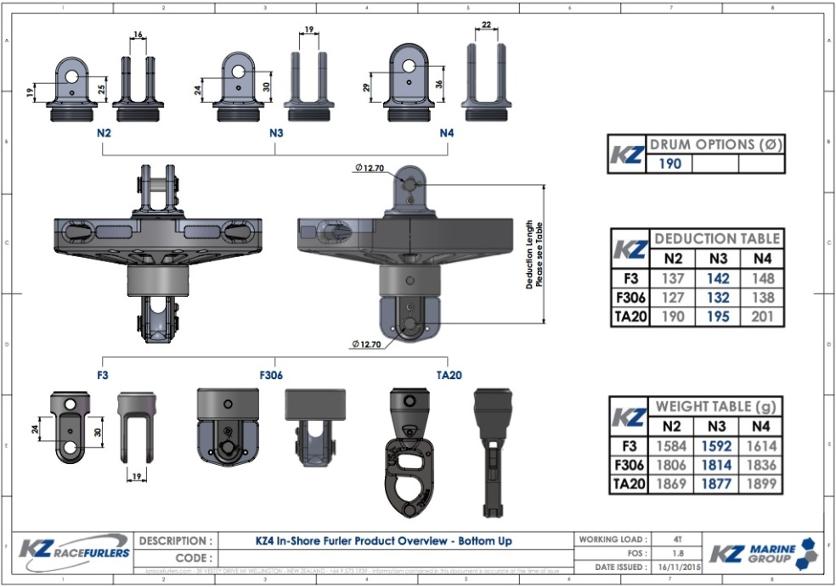How do I choose the right code zero or gennaker furler for my boat? Data from 8 well-known manufacturers is reviewed and conclusions drawn to help guide you to an appropriate unit for your needs. A quick review of the available data will tell you that sizing the correct furling unit for your boat is NOT an exact science!
Code Zero or Gennaker Furler sizing
The correct method for specifying a unit is by the Safe Working Load (SWL) and this is the one consistently available piece of information, across all manufacturers. Unfortunately few, if any, people really know the SWL of their forestay or their Code zero tack load.... and manufacturers cannot agree on the boundaries either! For example, Facnor, Karver and Harken all have code zero furlers with a SWL of 1500kg. At this load, Harken suggest a maximum recommended boat size of 33ft, whilst Karver push the boundary out to 36ft, and Facnor go all the way up to 39ft.
However, do not despair. It is possible to generalise, based on boat size, to get a ballpark SWL and then consider a number of variables to guide your final decision.
Code Zero or Gennaker Furler choice based on Boat Size
Summarising the data across a number of manufacturers, here at Upffront, we use the table below as an initial guide to required SWL, based on your boat size.
| Boat Size (ft) | SWL (kg) |
18 | 500 |
| 25 | 750 |
| 28 | 1000 |
| 35 | 1500 |
| 38 | 2000 |
| 41 | 2500 |
| 45 | 3000 |
| 49 | 4000 |
| 56 | 5000 |
| 60 | 6000 |
| 70 | 8000 |
| 80 | 10000 |
| 90 | 12000 |
As an example, if you have a 46ft boat you should be looking for a furling unit with a SWL of 3000-4000 kg, whilst a 50-53 ft boat might require something in the 4000-5000 kg range.
Code Zero or Gennaker Furler choice based on Displacement and Sail Size
- If you have a particularly heavy displacement boat and/or particularly large and powerful sail then you might consider a slightly larger unit
- If you have a multihull this will almost always push you into the next category up due to the increased stability and therefore, loads.

Code Zero or Gennaker Furler choice based on Drum diameter
- If you have narrowed your selection down to a few possible options, drum diameter is another important consideration
- A bigger drum provides more More torque / power which will be useful for a heavier, larger code zero
- A smaller drum delivers More speed - an essential component to successful top-down furling
- N.B. the smaller the drum the more power and line speed you need to be able to generate from either your winches or your arms (depending on boat size)
Last but not least, having considered all the factors above and you still have some options, weight is always a key decision criteria. This is no less important for cruising boats. Saving weight should be on your mind in every hardware and rigging choice made on your boat. Lowering the overall weight of your boat makes it stiffer and more powerful / responsive but also reduces the overall loads. This in turn, increases safety factors, reduces ware and ultimately increase the life of your hardware and rigging.
Code Zero or Gennaker Furler summary
As a conclusion, these following steps (roughly in order of importance) will help you understand how to choose - Code Zero or Gennaker Furler for your boat:
- Identify a suitable SWL range based on your boat size
- If you have a multihull - go one size up
- Is your displacement or sail particularly large/small which may influence the SWL above or below these average recommendations?
- If you have an existing cable - consider jaw width/depth and pin diameters
- If its for top-down you need to minimise SWL but consider all the other important criteria for effective furling and be prepared to accept the larger unit size
- Check your options on drum size and consider lock or no lock
- Finally choose the lightest one
If you have any questions about code zero and asymmetric furlers, please feel free to email us at [email protected], or click the link below to see our full range:


Code Zero or Gennaker Furler - how to choose the right one?